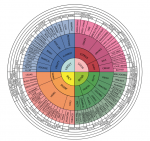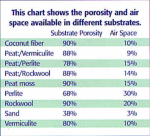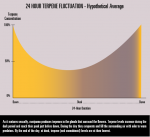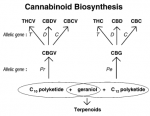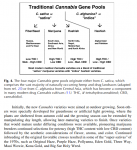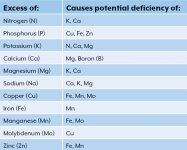Thought i would post a read from
@Phylex that goes into more depth about this chart. A MUST READ FOR ALL GROWERS.
WHY MODERN PLANT NUTRITION CREATES ANTAGONISM
Perhaps you’ve noticed that each of these core concepts touches on all the others. Plants are systems—intricate, delicate, and intertwined systems of biochemical reactions happening constantly within and around the plant.
Modern plant nutrition often called ‘NPK agriculture’, is based on the idea that if we add the major nutrients needed, plants will grow. Nature will always find a way to survive despite mistakes we may make, but that doesn’t mean that our plants are at optimal health.
NPK agriculture has shown us that this simplistic approach is not effective. Our crops are less nutritious, more susceptible to pests and disease, our soils are dead and infertile, and crop yields are decreasing around the world.
Perhaps the most important concept that can begin to fix this issue is the principle of nutrient antagonism. In a growing medium, nutrient molecules are constantly pushing and pulling at each other based on form and electrical charge. This ‘dance’ is fundamentally important to how well plants are able to take up and assimilate nutrients.
NPK agriculture doesn’t do a very good job of considering the balance of soil mineral contents and fertilizer inputs. Properly structured soil and balanced fertilizer programs help to balance the activity of nutrients and simulate natural environments.
Consider a virgin rainforest. The vastness and density of the vegetation are mind-boggling. The fruits and flowers are massive and incredibly flavorful. It’s also the most nutritious food found anywhere on earth. How this is possible without human interaction you wonder? It’s because nature has found ways to balance nutrients through microbial activity, natural soil remediation, and biological systems.
It’s impossible to fully replicate these intricate systems in isolated indoor (and many outdoor) environments. But we can learn from the biological rules and see many .of the same benefits.
OCHEMICAL SEQUENCING OF NUTRIENTS
It is important to understand that plants have a defined biological sequence of nutrient uptake. This starts with Boron, which stimulates the root system to leach sugars into the medium. These sugars feed the microbes, which transform silicates (Si) into silicic acid through a process called silicification. Silicic acid enhances Calcium uptake, fol- lowed by Organic Nitrogen (from L-Amino Acids), Magnesium, Phosphorus and Potassium.
These elements should be present in a bioavailable form to plants. If one nutrient in this sequence is not available (or less available), the uptake of all other elements in the sequence is more difficult or missed. It is very important to respect this sequence in order to avoid mineral deficiencies and/or nutrient uptake problems.
A common nutrient problem in indoor gardening is Calcium deficiency. This is because Calcium is immobile, meaning it doesn’t naturally move into and throughout plant tissue. Also, Calcium is pushed away by other minerals that are often added in large quantities, such as Nitrogen (as Nitrates) and Potassium.
Looking at the chart above we can see that Calcium is near the beginning of the sequence. And if Calcium uptake is limited in any way then all other nutrients uptake and availability will be affected. There are many other problems with Calcium deficiency that will be discussed later.
One of the best ways to increase Calcium availability and uptake (other than chelating with amino acids) is to optimize Silicon levels in the form of Silicic Acid. This is the beginning part of the biochemical sequence. In most indoor applications, silicic acid is rarely available because of the time it takes soil micro-life to naturally convert silicon into silicic acid. Even if a grower is adding a silica supplement (not in silicic acid form), virtually all of the silica remains in the growing medium until it is converted, which can take many weeks to months for any meaningful conversion.
Adding bioavailable silicic acid, as in FaSilitor, helps to increase the uptake and availability of Calcium and thus, all other nutrients. This is the natural mechanism and is far more efficient than any synthetic method.
DIAGNOSING PLANT PROBLEMS
It’s good to know how to identify and fix problems in plants. Ultimately, it’s better to prevent problems by understanding the underlying cause.
By providing proper nutrition in proper sequence and amounts to your plants from the beginning, many of these problems can be avoided. It is always better to maintain a preventative methodology versus curative.
Most times when a plant appears sick, the growers quickly goes to the internet or a book to reference the leaf discoloration or other symptom. This may give them a variety of answers. The grower picks the most common and logical, purchases a ‘remedy’, and tries to fix the plant. This usually doesn’t work because the grower is asking the wrong question.
Typical question:
Why is my plant having this symptom and how do I fix it?
Better question:
Why is my plant having this symptom and how do I prevent it?
Unfortunately diagnosing plant problems is usually not as simple as observing leaf discoloration or growth patterns. Really these symptoms are just clues, not answers. Most of the time growers need to look deeper to assure proper diagnosis, treatment, and later prevention.
CALCIUM DEFICIENCY
A common ‘deficiency’ growers experience is calcium. Calcium is immobile and is dif- ficult for plants to uptake and transport. The grower sees a sign of calcium deficiency and immediately adds additional Ca/Mg supplementation. However, most times there is plenty of calcium already in the growing medium. The issue is not deficiency; the issue is bioavailability.
The root cause is the broken biochemical sequence. Perhaps boron or silicic acid is unavailable or locked out. By understanding this sequence growers can provide the correct solution that truly solves the problem and not just a temporary fix.
Combining the skill of diagnosing problems with the understanding of biochemical sequencing is the most effective way to accurately solve problems.
NITROGEN DEFICIENCY
Another often misdiagnosed deficiency is Nitrogen. This usually appears as a even yellowing of leaves, indicating slowed photosynthesis. A grower will quickly add more Nitrogen as an attempt to fix the problem. Sometimes this works but doesn’t always solve the real issue.
Nitrogen moves from the roots to the lower leaves. Then with the help of the enzyme nitrogenase, Nitrogen moves from the lower leaves to the upper leaves (new growth). Nitrogenase is stimulated by the presence of Molybdenum (Mo). If Molybdenum is deficient, this process is slowed and deficiencies may appear in the upper leaves.
If upper leaves are yellowing and lower mature leaves are still properly green (has proper N levels), then more likely there is a Molybdenum problem. In this case, adding more N may cause unwanted problems in the growing medium.
ANTAGONISTIC ACTION OF NUTRIENTS
It is very important to understand how certain nutrients react with each other. If you don’t understand these interactions, you may over-supplement with a specific nutrient in attempt to correct a deficiency.
Not all deficiencies are caused by a lack of nutrients! For example, Calcium deficiency may be diagnosed due to low Calcium levels OR because there are high levels of Nitrates (NO3). Nitrates ‘push’ Calcium away and can block absorption.
So you should use organic Nitrogen instead of inorganic Nitrogen, which is high in Nitrates. Many modern synthetic fertilizers contain primary Nitrates or other salt-based forms of nitrogen. The salts are the most common cause of tip burn, nutrient antago- nism, and weak plant growth (more on that later).
The antagonistic action of nutrients shows how overdoses of certain elements can lock out or displace another element. This list shows which elements react with each other. Understanding nutrient antagonism makes diagnosing deficiencies and excess more difficult, but ultimately more accurate.

